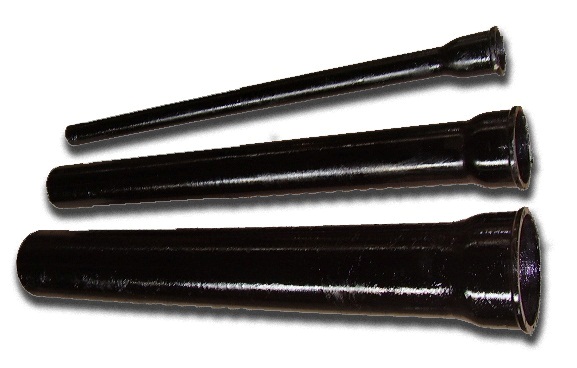Thanks to the development of technologies for sewerage, polymer pipes have long been actively used, but still most communications are still made of cast iron. Since the 70s, all cast iron pipes and fittings have been produced in strictly defined sizes, which allows them to be replaced and repaired without any problems. The situation is a little more complicated with networks laid earlier. But even there, thanks to socket connections and adapters, it is possible to choose the desired diameter of cast-iron sewer pipes. Produced pipes have different weight, length, diameter, wall thickness. It is the ratio of these parameters that allows you to choose the necessary products to create durable and reliable sewer systems.
Types of diameters and marking of pipes.
The most important indicator that affects the choice of products for any type of sewerage device, both internal and external, is the diameter of the pipe. In regulatory documents, there are several standard sizes that characterize the outer, inner and nominal diameters of the pipe, the nominal diameter and wall thickness.
Installers are guided by the nominal diameter when selecting components (it is usually indicated on the drawing in the letter designation Dn or day). Nominal diameter (denoted Dy or Doo) indicates the inside diameter in millimeters. Outer diameter (letter marking G) is considered the main one in the calculation of the future system. The length of the pipe is indicated by the letter L.
These indicators guarantee the right choice of products for a specific task. For example, the outer diameter is chosen:
- for indoor sewerage (drainage from a washing machine, dishwasher, shower, washbasin, bath) - up to 5 cm;
- to drain the drain from the toilet, a pipe Ø110 mm is used;
- for the installation of risers and drainage from the building - from 110 to 200 mm;
- pipes Ø300 mm are used to divert wastewater in private houses;
- for the construction of sewer collectors, pipes from 500 to 1200 mm are used.

The diameter of cast iron sewer pipes and wall thickness are interdependent values. So, as a standard for a pipe with a nominal bore of 100 mm, the wall thickness for different classes will be from 7.5 to 9 mm, and for 150 mm - from 8.3 to 10 mm.
The weight of the product also depends on the diameter and wall thickness. For example, the weight of a meter of pipe with the same diameter and different wall thicknesses (7.4 and 8 mm) will differ by 1 kg.
The sockets for cast iron products have a standard length of 6-8 cm, and the length can vary from 75 to 220 cm. GOST 6942-98 regulates the range of cast iron pipes with diameters of 5, 10 and 15 cm.
Marking of cast-iron pipe products (according to GOST) is carried out according to the conditional passage. For example, you can decipher the marking "TCHK-100-2100-B" as follows - a cast-iron sewer pipe, Doo(nominal bore) - 50 mm, length - 2100 mm, delivery class - B.
Types and classes of pipes.
Functionally, sewer cast iron pipes are of two types:
- socketed (SME - one end is smooth, the other is with a socket)
- socketless (SMU - both ends are smooth).
The strength and reliability of any pipeline, whether it be an internal or external sewage system, directly depends on the thickness of the pipe. The pressure and load withstand by the pipe depends on this parameter. Therefore, socket products are divided into classes - A, B, LA.
Class A pipes are used in the installation of areas most at risk. These include pipes that can withstand a pressure of 0.1 even without coating.
Class B includes pipes that can withstand this pressure after being treated with a bituminous anti-corrosion layer. They are distinguished by greater wall thickness, high strength and increased service life. They are mainly used for the installation of internal sewerage.
Cast iron pipes of class LA are mainly used for sewerage in low-rise construction, where heavy loads are not expected, since they can withstand a maximum pressure of not more than 25 kgf / cm².
For the installation of sewer systems at industrial facilities, pipes with a large diameter are required, which are regulated by GOST 9583-75. They are available in lengths from 2 to 10 meters and diameters from 65 to 120 cm.


















